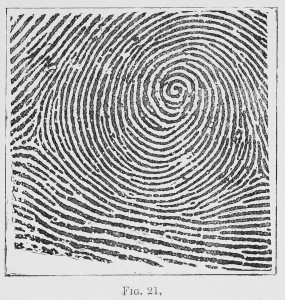One of the oldest types of evidence used in criminal investigations is the fingerprint. During the 1870s, Henry Faulds, a Scottish doctor working in a Tokyo hospital, studied fingerprints as identifying marks. After he applied his research in a criminal case, Faulds offered to fund a fingerprint bureau at Scotland Yard. But police officials were not interested.
Faulds published his observations about fingerprints in 1880. The report came to the attention of Francis Galton, a nephew of Charles Darwin. Galton investigated fingerprints and concluded that fingerprints remain the same during an individual’s lifetime, and that no two fingerprints are identical. He suggested a system of fingerprint identification in his book, Finger Prints (1892).
Eight years later, Edward R. Henry, Commissioner of the Metropolitan Police, published his book, The Classification and Use of Finger Prints, which also proposed a method of fingerprint classification. New Scotland Yard launched a three-person Fingerprint Branch in July 1901. The department used the Henry system of classification, which has become the core of fingerprint systems in most English-speaking countries.
Prepared by the International Association for Identification, The Fingerprint Sourcebook (2011) is an excellent resource for many aspects of fingerprint identification practice. The National Institute of Justice offers a free copy of the book on its website.

